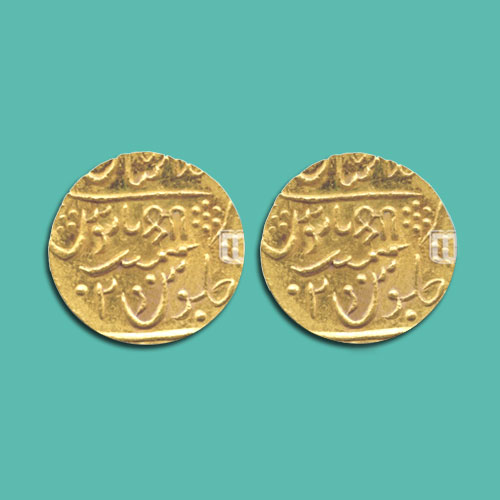Baija Bai of Gwalior issued gold Mohur
2021-09-07 Tue
The gold Mohur of 11-12 grams was issued by Regent Baija Bai from Lashkar mint in 1130 AH. The inscription on the obverse side reads, “Sikke Mubarak Sahib Qiran Sani Muhammad Shah Gazi” in Persian legend with AH date. And the reverse side features, “Shri in Devanagari, RY date 2, Julus Mainamat Manus and the mint name”.The Princely state of Gwalior existed in the mid-18th century as a part of the Maratha confederacy. It was founded in 1761 by RanojiShinde who was an accomplished soldier, local Chieftain and Governor. He served under PeshwaBaji Rao as one of the top three senior commanders. Ranoji is known as the founder of the Scindia dynasty. He first set his headquarters in the ancient city of Ujjain; a city that remained the capital for the Scindias until 1810.
The Gwalior state received a 21 gun salute and held a pivotal position for its strategic location and fort strength. It became a part of the British suzerainty after the Anglo-Maratha wars. It was the largest state of the Central India Agency which was a political office of British India.
Image Courtesy: Mintage World
Latest News
-
Ghiyath Shah as Heir Apparent
2025-09-25 ThuGhiyath Shah was the ruler of the Malwa Sultanate, reigning from 1456 to 1500. From 1456 to 1469, he...
-
Malwa Sultan Mahmud Shah Silver Coins
2025-09-11 ThuMalwa Sultan Mahmud Shah minted silver coins in round and square flans. <br><br> For round coins,...
-
Malwa Sultan Mahmud Shah Billon coin
2025-08-26 TueMalwa Sultan Mahmud Shah's billon coins followed three weight standards: 100 rati, 96 rati, and 80 r...
-
Fascinating Archaeological Facts on Postage Stamps - 91
2025-08-23 SatRhinoceros is one of the oldest land mammal species existing in India. There are five species of rhi...
-
Fascinating Archaeological Facts on Postage Stamps - 90
2025-08-23 SatUthiramerur, a Village in Kanchipuram, Tamil Nadu, is notable for its Temple inscriptions that descr...

